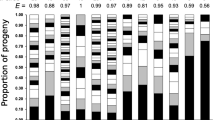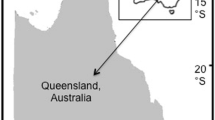Abstract
In many mating systems, males adopt alternative reproductive tactics (ARTs) to maximize reproductive success. In fishes, guarding males often invest more energy into courtship, defense, and paternal care, whereas cuckolding males forego such costs and steal fertilizations by releasing their sperm in the nest of a guarding male. These two tactics have been documented in the plainfin midshipman fish (Porichthys notatus), yet the relative reproductive success of the guarding and cuckolding male tactics remains unknown. In this study, we used microsatellite markers to determine the level of paternity of the guarding type I males. We explored how paternity varied with male phenotype and across the breeding season. Our results revealed the lowest documented levels of paternity in a species with obligate paternal care. Although paternity remained consistently low, it did increase as the breeding season progressed. Male body size did not significantly predict paternity. The low paternity in this species may be explained, in part, by aspects of their reproductive ecology including the duration of parental care period, limited nest availability and competition for nests, as well as the occurrence of nest takeovers. Overall, our findings contribute to the understanding of the ultimate factors underlying ARTs in this species and highlight the importance of investigating reproductive success across the entire breeding season.


Similar content being viewed by others
References
Alonzo SH, Heckman KL (2010) The unexpected but understandable dynamics of mating, paternity and paternal care in the ocellated wrasse. Proc R Soc B 277:115–122
Altmann SA, Wagner SS, Lenington S (1977) Two models for the evolution of polygyny. Behav Ecol Sociobiol 2:397–410
Arora HL (1948) Observations on the habits and early life history of the batrachoid fish, Porichthys notatus Girard. Copeia 1948:89–93
Avise JC, Jones AG, Walker D, DeWoody JA et al (2002) Genetic mating systems and reproductive natural histories of fishes: lessons for ecology and evolution. Annu Rev Genet 36:19–45
Balon EK (1999) Alternative ways to become a juvenile or a definitive phenotype (and on some persisting linguistic offenses). Environ Biol Fish 56:17–38
Bass AH (1992) Dimorphic male brains and alternative reproductive tactics in a vocalizing fish. Trends Neurosci 15:139–145
Blackwell BG, Brown ML, Willis DW (2000) Relative weight (Wr) status and current use in fisheries assessment and management. Rev Fish Sci 8:1–44
Brantley RK, Bass AH (1994) Alternative male spawning tactics and acoustic signals in the plainfin midshipman fish Porichthy notatus Girard (Teleostei, Batrachoididae). Ethology 96:213–232
Brantley RK, Marchaterre MA, Bass AH (1993) Androgen effects on vocal muscle structure in a teleost fish with inter- and intra-sexual dimorphism. J Morph 216:305–318
Bessert ML, Brozek J, Orti G (2007) Impact of nest substrate limitations on patterns of illegitimacy in the fathead minnow, Pimephales promelas (Cypriniformes: Cyprinidae). J Hered 98:716–722
Brockman HJ, Nguyen C, Potts W (2000) Paternity in horseshoe crabs when spawning in multiple-male groups. Anim Behav 60:837–849
Cargnelli LM, Neff BD (2006) Condition-dependent nesting in bluegill sunfish Lepomis macrochirus. J Anim Ecol 75:627–633
Clutton-Brock TH (1991) The evolution of parental care. Princeton University Press, Princeton
Clutton-Brock TH, Rose KE, Guiness FE (1997) Density-related changes in sexual selection in red deer. Proc R Soc B 264:1509–1516
Coleman RM, Fischer RU (1991) Brood size, male fanning effort and the energetics of a nonshareable parental investment in bluegill sunfish, Lepomis macrochirus (Teleostei: Centrarchidae). Ethology 87:177–188
Coleman RM, Gross MR (1991) Parental investment theory: the role of past investment. Trends Ecol Evol 6:404–406
Coleman RM, Gross MR, Sargent RC (1985) Parental investment decision rules: a test in bluegill sunfish. Behav Ecol Sociobiol 18:59–66
Coleman SW, Jones AG (2011) Patterns of multiple paternity and maternity in fishes. Biol J Linn Soc 103:735–760
Coltman D, Smith J, Bancroft D, Pilkington J, MacColl D, Clutton-Brock T, Pemberton J (1999) Density-dependent variation in lifetime breeding success and natural and sexual selection in Soay rams. Am Nat 154:730–746
Crane JM Jr (1981) Feeding and growth by the sessile larvae of the teleost Porichthys notatus. Copeia 1981:895–897
DeMartini EE (1988) Spawning success of the male plainfin midshipman. I. Influences of male body size and area of spawning site. J Exp Mar Biol Ecol 121:177–192
DeMartini EE (1990) Annual variations in fecundity, egg size and condition of the plainfin midshipman (Porichthys notatus). Copeia 1990:850–855
DeMartini EE (1991) Spawning success of the male plainfin midshipman. II. Substratum as a limiting spatial resource. J Exp Mar Biol Ecol 146:235–251
DeWoody JA, Fletcher DE, Wilkins SD, Avise JC (2000) Parentage and nest guarding in the tessellated darter (Etheostoma olmstedi) assayed by microsatellite markers (Perciformes: Percidae). Copeia 2000:740–747
Dugatkin LA (1992) Sexual selection and imitation: females copy the mate choice of others. Am Nat 139:1384–1389
Emlen ST, Oring LW (1977) Ecology, sexual selection, and the evolution of mating systems. Science 197:215–223
Fechhelm RG, Griffiths WB, Wilson WJ, Gallaway BJ, Bryan JD (1995) Intra- and interseasonal changes in the relative condition and proximate body composition of broad whitefish from the Prudhoe Bay Region of Alaska. Trans Am Fish Soc 124:508–519
Forsgren E, Kvarnemo C, Lindström K (1996) Mode of sexual selection determined by resource abundance in two sand goby populations. Evolution 50:646–654
Foster WA, Treherne HE (1981) Evidence for the dilution effect in the selfish herd from fish predation on a marine insect. Nature 293:456–467
Gross MR (1980) Sexual selection and the evolution of reproductive strategies in sunfishes (Lepomis: Centrarchidae). Dissertation, University of Utah
Hubbs CL (1920) The bionomics of Porichthy notatus Girard. Am Nat 54:380–384
Ibara RM, Penny LT, Ebeling AW, van Dykhuizen G, Caillet G (1983) The mating call of the plainfin midshipman fish, Porichthys notatus. In: Ward JA (ed) Predators and prey in fishes. Dr W Junk Publishers, The Hague, pp 205–212
Jones AG, Small CM, Paczolt KA, Ratterman NL (2010) A practical guide to methods of parentage analysis. Mol Ecol Resour 10:6–30
Jones OR, Wang J (2010) COLONY: a program for parentage and sibship inference from multilocus genotype data. Mol Ecol Resour 10:551–555
Lank DB, Smith CM, Hanotte O, Ohtonen A, Bailey S, Burke T (2002) High frequency of polyandry in a lek mating system. Behav Ecol 13:209–215
Lee JSF, Bass AH (2004) Does exaggerated morphology preclude plasticity to cuckoldry in the midshipman fish (Porichthys notatus). Naturwissenschaften 91:338–341
Miller DJ, Lea RN (1972) Fish Bulletin 157: guide to the coastal marine fishes of California. Scripps Institution of Oceanography, UC San Diego, pp 72–73
Møller AP (2000) Male parental care, female reproductive success, and extrapair paternity. Behav Ecol 11:161–168
Møller AP, Thornhill R (1998) Male parental care, differential parental investment by females and sexual selection. Anim Behav 55:1507–1515
Neff BD (2001) Genetic paternity analysis and breeding success in bluegill sunfish (Lepomis macrochirus). J Hered 92:111–119
Neff BD, Clare EL (2008) Temporal variation in cuckoldry and paternity in two sunfish species (Lepomis spp.) with alternative reproductive tactics. Can J Zool 86:92–99
Neff BD, Repka J, Gross MR (2000a) Parentage analysis with incomplete sampling of candidate parents and offspring. Mol Ecol 9:515–528
Neff BD, Repka J, Gross MR (2000b) Statistical confidence in parentage analyses with incomplete sampling: how many loci and offspring are needed? Mol Ecol 9:529–539
Oliveira RF, Almada VC, Forsgren E, Gonçalves EJ (1999) Temporal variation in male traits, nesting aggregations and mating success in the peacock blenny. J Fish Biol 54:499–512
Porter BA, Fiumera AC, Avise JC (2002) Egg mimicry and allopaternal care: two mate attracting tactics by which nesting striped darter (Etheostoma virgatum) males enhance reproductive success. Behav Ecol Sociobiol 51:350–359
Pritchard JK, Stephens M, Donnelly P (2000) Inference of population structure using multilocus genotype data. Genetics 155:945–959
Ridley M, Rechten C (1981) Female sticklebacks prefer to spawn with males whose nests contain eggs. Behaviour 76:152–161
Rohwer S (1978) Parent cannibalism of offspring and egg raiding as a courtship strategy. Am Nat 112:429–440
Schultz ET (1993) The effect of birth date on fitness of female dwarf perch, Micrometrus minimus. Evolution 47:520–539
Sefc KM, Hermann CM, Koblmüller S (2009) Mating system variability in a mouthbrooding cichlid fish from a tropical lake. Mol Ecol 18:3508–3517
Shuster SM (1989) Male alternative reproductive strategies in a marine isopod crustacean (Paracerceis sculpta): the use of genetic markers to measure differences in fertilization success among α-, β-, and γ-males. Evolution 43:1683–1698
Sisneros JA, Alderks PW, Leon K, Sniffen B (2009) Morphometric changes associated with the reproductive cycle and behaviour of the intertidal-nesting, male plainfin midshipman Porichthys notatus. J Fish Biol 74:18–36
Suk HY, Neff BD, Fitzpatrick JL, Balshine S (2009) Isolation and characterization of polymorphic microsatellite loci in the plain midshipman fish. Hereditas 146:001–004
Taborsky M, Oliveira RF, Brockman HJ (2008) The evolution of alternative reproductive tactics: concepts and questions. In: Oliveira RF, Taborsky M, Brockman HJ (eds) Alternative reproductive tactics. Cambridge University Press, New York, pp 1–21
Verhulst S, van Balen JH, Tinbergen JM (1995) Seasonal decline in reproductive success of the great tit: variation in time or quality? Ecology 76:2392–2403
Wang J (2004) Sibship reconstruction from genetic data with typing errors. Genetics 166:1963–1979
Westneat DF, Sherman PW (1992) Parentage and the evolution of parental behavior. Behav Ecol 4:66–77
Acknowledgments
We thank Celia Chui, John Fitzpatrick, Ahdia Hassan, Julie Marentette, Jen Reynolds, Natalie Sopinka, and Jonathan Taves for their assistance with data collection in British Columbia. We thank Michael Roubakha, Shawn Garner, Cayli Hunt, and Amanda Pereira for their assistance with DNA extractions and sample analyses. We thank Cayli Hunt, Erin McCallum, Ryan Caldwell, and Celeste Bouchard for assistance with developing classification scheme and its validity. We also thank Mr. and Mrs. Cogswell, Mr. and Mrs. Weatherell, and especially Mr. and Mrs. Flader for providing access to midshipman habitats and lodgings for field crew. This work was funded by the Natural Sciences and Engineering Research Council of Canada (grants to S.B. and B.D.N.).
Ethical standards
This work conformed to the guidelines outlined by the Canadian Council on Animal Care, and permission to undertake this work was granted by the Department of Fisheries and Oceans, and the First Nations Bands in which sampling occurred.
Conflict of interest
The authors declare that they have no conflict of interest.
Author information
Authors and Affiliations
Corresponding author
Additional information
Communicated by A. Pilastro
Rights and permissions
About this article
Cite this article
Cogliati, K.M., Neff, B.D. & Balshine, S. High degree of paternity loss in a species with alternative reproductive tactics. Behav Ecol Sociobiol 67, 399–408 (2013). https://doi.org/10.1007/s00265-012-1460-y
Received:
Revised:
Accepted:
Published:
Issue Date:
DOI: https://doi.org/10.1007/s00265-012-1460-y




